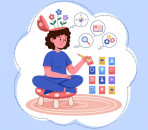Online 16 Personality Types Test (MBTI-Based)
New Updates



Take 16 Personalities Test Online
Get StartedMBTI 16 Personalities Test: Find Out Who You Really Are in Minutes
Personality typing fascinates people because it offers a shared language for discussing motivations, decision-making, and collaboration. Instead of vague labels, this framework maps how individuals prefer to gather information and make choices, then blends those preferences into a recognizable profile. Readers are drawn to the way it balances clarity with nuance, offering a doorway into self-knowledge without demanding a degree in psychology. Over time, the model has evolved from a niche interest into a global conversation, showing up in classrooms, careers, and coaching.
Many discover that a type profile helps them articulate strengths they previously felt but struggled to describe clearly. Many readers start with the 16 personalities test to get a baseline before diving deeper into research. With that starting point, they can track real-world patterns, compare notes with peers, and refine self-awareness through reflection.
The broader appeal comes from pairing structure with storytelling, letting data intersect with lived experience. For newcomers, a concise overview often clarifies what a 16 personality test measures beyond trendy labels. Later, people learn to treat the result as a hypothesis to be validated in their relationships, projects, and personal growth routines.

How the Test Works: Preferences, Dichotomies, and Patterns
At its core, the framework assesses preferences rather than skills, assigning a type code by combining four pairs of opposites. These pairs reflect where you tend to focus attention, how you prefer to take in information, the way you evaluate choices, and how you like to organize life. Because preferences sit on spectrums, two individuals with the same code can still look quite different in practice. That’s why context matters: stress, culture, and goals all shape how a profile shows up day to day.
After responding to a series of items, your results point toward a best-fit code that becomes a jumping-off point for reflection. When people discuss types in everyday conversation, they are usually referencing the popular label set known as 16 personalities, even if they interpret traits loosely. The most helpful approach is to examine how each preference pair appears in your actual habits rather than relying on stereotypes. Because assessment quality varies, test design influences the clarity of your outcome and the usefulness of the explanations you receive. If you prefer a structured questionnaire, you’ll likely encounter the familiar format marketed as MBTI test 16 personalities, which organizes answers into clear preference pairs. High-quality implementations also provide reliability data and practical tips so your insights translate into meaningful change.
- Results describe preference, not ability or potential.
- Context can amplify or soften certain traits over time.
- Self-reflection often improves accuracy more than retesting.
- A good debrief turns labels into actionable learning.
Benefits: Self-Awareness, Communication, and Career Growth
A well-explained profile can reduce vague self-criticism by naming the patterns behind your strengths and stress points. Once vocabulary replaces guesswork, it becomes easier to design habits that boost energy and minimize friction. Managers and teammates benefit too, because shared language normalizes different work styles instead of turning them into conflicts. In relationships, this insight lays the groundwork for empathy, clearer requests, and smoother problem-solving. People often begin by mapping communication habits, such as how much detail they want or how quickly they make decisions. For a playful starting point, some individuals warm up with a 16 personalities quiz before moving on to a comprehensive report. The moment you connect a preference to a specific behavior, you unlock practical experiments that stick.
Career planning becomes more intentional when you understand environments that energize rather than drain you. In more formal contexts, coaches may refer to the long-standing phrase Myers-Briggs test 16 personalities when explaining how dichotomies translate into daily behavior. That discussion often leads to customized strategies for interviewing, leadership communication, and time management. Accessibility also matters, and many people want an approachable way to start learning. Budget-conscious learners often search for options labeled free MBTI test online 16 personalities while comparing site credibility and privacy policies. After that introductory experience, a deeper workbook or guided debrief can elevate insights into a real development plan.
- Create a personal “energy map” to track tasks that recharge or deplete you.
- Draft a one-page “how to work with me” guide for teammates.
- Run small weekly experiments to test new collaboration habits.
- Use reflection prompts to turn patterns into repeatable practices.
Practical Applications at a Glance
Turning theory into action is easier when you can see examples organized by domain. The matrix below summarizes common use cases and specific, practical moves you can make this month. Use it as a quick-reference companion while you experiment with new routines at work, at home, and in your studies.
| Domain | Use Case | Practical Tip |
|---|---|---|
| Workplace | Improve handoffs between teammates with different decision speeds | Agree on a “decision deadline” and a checklist of minimum info |
| Leadership | Balance strategic vision with operational follow-through | Pair big-picture roadmaps with weekly action reviews |
| Learning | Match study methods to information preferences | Blend visuals, summaries, and practice problems for retention |
| Relationships | Reduce conflict from mismatched communication styles | Clarify intent, confirm needs, and set timing for sensitive talks |
| Well-being | Manage stress triggers aligned with preference patterns | Design recovery rituals and boundaries for peak times |
As you apply these ideas, track outcomes in a simple journal so you can adjust quickly. Small, consistent changes outperform sweeping overhauls, especially when you’re testing new collaboration habits. Over a few weeks, you’ll see which experiments deliver the biggest gains in clarity, morale, and performance, making your insights truly sustainable.
Interpreting Results Responsibly: Strengths and Limits
Type language becomes most powerful when treated as a lens, not a cage. Each preference speaks to a pattern you can lean on, but every person can still use the full range of behaviors when the moment calls for it. That flexibility is a hallmark of growth, so avoid turning codes into excuses or predictions about someone’s ceiling. You are a dynamic system, not a static label, which is why context-aware applications matter.
Cost and convenience can influence where you start, yet rigor should guide how you proceed. Some websites advertise a 16 personalities test free experience, yet it’s wise to evaluate question quality and scoring transparency. When you treat results as data to be validated rather than facts to be memorized, you keep the benefits without the blind spots. Short tools can kick off helpful dialogue, while richer reports offer deeper pattern recognition. Short form assessments marketed as a 16 personality types quiz can feel fun, but they should not replace a thoughtful debrief. Whenever possible, pair your results with observation, feedback, and specific behavior experiments to stress-test insights.
- Use results to frame questions, not to finalize conclusions.
- Invite colleagues or friends to share observations for balance.
- Revisit your notes after major life or role changes.
- Beware of stereotyping; focus on behaviors and contexts.

Choosing a Quality Assessment and Using Your Results
Not all questionnaires are created equal, and your choice influences both accuracy and usefulness. Look for clear descriptions of how items were created, how scoring works, and whether the report includes practical guidance. Privacy and data retention policies matter too, especially if you plan to share results with a coach or employer. A transparent provider respects your time, your data, and your learning curve. Independent reviews and sample reports can help you preview what you’ll receive. Before signing up anywhere, examine what a provider means by a 16 personality type test and whether norms and validation data are published. The more you can see upfront, the better your chances of getting a trustworthy and actionable result.
Consider what outcome you want: a quick snapshot, a deep dive, or coaching support. For accuracy’s sake, check how a platform defines a personality test 16 personalities so you understand the scope and any methodological caveats. With a clear goal and the right tool, you’ll convert curiosity into measurable growth. Terminology can be confusing because many sites blend classic and modern language. When browsing, you might see the phrase 16 personalities test Myers-Briggs, which typically signals a familiar format but not necessarily identical scoring rules. Reading the fine print saves you from mismatched expectations and ensures you know exactly what’s being offered.
- Scan sample pages for depth, clarity, and actionable advice.
- Prefer providers that share reliability and validity information.
- Check whether your data can be deleted on request.
- Plan a post-results routine with concrete next steps.
Take 16 Personalities Test Online
Get StartedFAQ: Your Top Questions Answered
-
Is this approach scientific or just a fun label system?
It sits somewhere in between: useful for structured self-reflection, but not a clinical diagnosis or a predictor of destiny. If cost is a concern, you may locate a 16 personalities test full free, but remember to weigh data privacy and the reputation of the source. The most responsible practice is to combine results with observation, feedback, and iterative experiments.
-
What’s the best way to get started without feeling overwhelmed?
Begin with a short overview, skim a few type descriptions, and note what resonates in your day-to-day routines. For social learning, a lightweight 16 personality quiz can kick off a conversation, and then you can revisit the report after some reflection. The key is to move from reading to small, low-stakes experiments as soon as possible.
-
How does this relate to workplace training and team development?
Teams benefit from shared vocabulary that normalizes different communication needs and decision speeds. Within organizational training, the umbrella nickname MBTI 16 personalities often shows up in agendas even when facilitators use modernized language. The most effective workshops convert insights into concrete agreements about meetings, feedback, and handoffs.
-
Can my type change over time or across contexts?
Your core preferences tend to be stable, but behavior naturally flexes across roles, stress levels, and environments. Context changes, which strengths show up first, so it’s normal to notice different expressions at home versus work. What matters most is intentional flexibility that preserves your energy while meeting the moment.
-
How do I use results ethically with friends or coworkers?
Lead with consent, curiosity, and humility, and avoid turning codes into shortcuts for judgment. Ask people how they prefer to work or communicate, then co-create norms that respect individual differences. The goal is better collaboration, not categorization, and that starts with listening.
 MBTI 16 Types: A Practical, Insightful Guide for Curious Minds
MBTI 16 Types: A Practical, Insightful Guide for Curious Minds